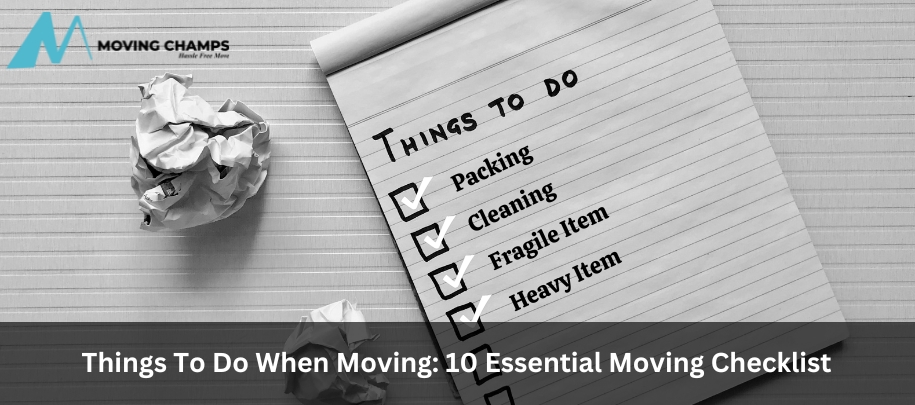When you decide to move into a new house, there is a lot to think about. And while we often consider moving or relocating steps like packing and unpacking to be the only significant obstacles to fully settling in, it’s the things you do after you move into a new home that makes the most difference.
Getting acquainted with your home, learning how it works, and prioritizing which projects you want to tackle are all part of assuming your role as a homeowner—and it’s better to do it all right away rather than waiting and taking you’ll figure it out later.
Of course, you already have a lot going on. So, to help you organize your to-do list, we’ve compiled a quick list of things to do when moving to a new house.
Most of these steps aren’t too time-consuming, but they do necessitate a conscious effort on your part to complete them.
Read on to find out what you require to know, then make a plan. Soon, you’ll be able to relax, crack open the champagne, and toast your new home.
Essential Things To Do When Moving To A New Home Are:
1. Perform A Walkthrough
There is no better time to conduct a thorough walkthrough of your new home than when it is empty. So, look around before you start unpacking and setting up your furniture (and, even better, before you unload the moving truck—if possible). It would be best if you double-checked, among other things, that:
- The previous owner completed all requested agreed-upon repairs.
- The house contains everything that is supposed to be included in the sale.
- Everything, including outlets, switches, and fixtures, is operational.
If you discover an issue that violates the sale contract terms (for example, the previous owner took the washer and dryer with them when they were supposed to leave them behind), contact your realtor immediately to determine your options. Concerning issues not covered in your contract, they are now your responsibility, but it is helpful to know what they are.
2. Safety Of Your Pet And Child
Suppose you are moving or shifting into a new home with small children (or even furry four-legged children). In that case, the first step will be preliminary childproofing to keep everyone safe until you can complete your entire moving setup.
Check out our article on how to quickly childproof a home on a moving day for tips like creating a separate, kid-free zone for discarded packing things and checking all windows to ensure they’re securely closed.
They don’t have any long hanging cords coming off of the blinds. Keep anything dangerous (box cutters, cleaning supplies, glassware, etc.) out of reach of small children.
3. Figure Out What’s Going On And Where It’s Going
When moving into a new home, making a plan of attack for setting everything up instead of winging it will save you a lot of time and trouble. This is particularly true for large items like furniture.
While you probably already have a general idea of what goes in what room, take a moment to consider how you’d like the setup to look. Of course, you can make changes later, but going into this task with a general plan will always make the job easier.
4. Ensure That Your Utilities Are Operational
Hopefully, you took care of arranging for your utilities to be ready for you before moving into your new home, in which case, now is the time to ensure that everything is prepared to go and working correctly. On a moving day, double-check that your electric, gas, water, heating and cooling, phone, and internet are operational. Then, contact your local waste management facility to ensure your new home is also set up for garbage pickup.
5. Find The Fuse Box And The Water Valve
You don’t want to be looking for the fuse box or the water valve when you need them. It’s much better to mark their locations now so that if your power goes out or you need to turn off the water for some reason, you can get there quickly.
As a general rule, your fuse box will be in your basement, garage, or storage room, whereas your home’s water valve will be somewhere around the perimeter of your house. Being aware of these locations and marking them clearly can save you time and frustration during emergencies or maintenance tasks.
6. Perform A Thorough Cleaning
After moving, the last thing you want to do is clean your new home from top to bottom, but the best time to do it is immediately after moving. Fortunately, we’ve put together a guide on cleaning deep a new home that can assist you.
If you don’t have the time or inclination to put on your cleaning gloves and grab a mop right now (and we understand), consider hiring professional cleaning services instead. Whether you pay in terms of time or money, starting life in your new home in a clean state is well worth it.
7. Repairs Should Be Prioritised
Unless you’re moving into a new home with no previous owners, you’ll have some repair projects. It would be best if you had a general idea of what these are based on your home or area’s inspection, but it never hurts to walk around on your own and get a sense of what is required to be done and what is at the top of the priority list.
While you don’t have to start working on these repairs right away (there will be plenty of time for that once you’ve settled in), make a list of what needs to be done and in what order you intend to do. However, creating a list of necessary repairs and prioritizing them can provide a better understanding of the urgency and help establish a solid plan when it’s time to start.
8. Change Your Locks
Changing the locks in your new home is always a good idea. Even if you don’t have any reservations about the previous owner, you never know who might have a key. This is one of those situations where it’s better to be safe than sorry, so call a locksmith or change the locks yourself if you’re feeling brave.
Rekey the locks on all doors leading from the inside to the outside of your home and the windows. It’s a small price for a great deal of peace of mind.
9. Update Your Contact Information
You may have already changed your address with the post office before moving day, but if you haven’t done so yet, now is the time. Notify friends and family, subscription services, your bank, loan providers, and anyone else who sends you regular correspondence or bills about your move.
A complete list of who needs to be notified can be found here. If you’ve relocated to a new state, you’ll also need to contact your state’s Department of motor vehicles to obtain a new driver’s license and vehicle registration.
10. Get To Know Your Neighbours
Getting to know your neighbours is an essential part of settling into a new home and community. Taking the time to introduce yourself and establish friendly connections can create a warm and welcoming atmosphere for everyone. Not only does it foster a sense of belonging, but it also opens the door to valuable support systems and local insights. When you begin to connect with others, it’s important to remember that even a simple act such as smiling or waving can make a big difference. Participating in casual conversations or joining local events can result in long-lasting friendships and foster a strong sense of community among neighbours.
Conclusion
In conclusion, the process of moving into a new house extends far beyond the physical act of packing and unpacking. Once you arrive at your new home, there are crucial steps that require attention to ensure a smooth and successful evolution into your new role as a homeowner. Taking the time to familiarize yourself with your new space, prioritizing tasks, and attending to necessary preparations will make all the difference in settling into your new abode.
By diligently completing the essential steps mentioned above, you can confidently settle into your new home and enjoy the fruits of your efforts. Remember, taking the time and effort to make your new house truly yours will lead to a more fulfilling and enjoyable homeownership experience. So, after completing these necessary tasks, take a moment to savour your accomplishments, raise a glass to your new home, and embrace the exciting journey ahead.
If you need any assistance or have further questions about moving into your new home, don’t hesitate to reach out to us at Moving Champs Canada. Our team of professional house movers is here to help you every step of the way.
You can contact us at:
Call us at: +1-6479322202
Or can also mail us on: info@movingchamps.ca
Related Blogs
How To Organize A Home Library
In the digital age, where information is increasingly consumed through screens and devices, the allure of a physical book remains as captivating as ever. For bibliophiles and avid readers, their cozy home library is more than just repositories of knowledge; they are...
8 Factors That Influence Your Cost Of Moving
We are aware of how much you cherish your possessions and how much they mean to you. However, when you have to move to a different site, a problem occurs. Shipping a car or home items may be expensive and time-consuming. The cost of moving home goods is not fixed and...
Tips To Childproof A Home On A Moving Day
The moment you have been waiting for so long has finally arrived – moving day! While you may feel excited about the progress you've made in preparing for the move, it's essential to prioritize your child's safety on this big day. Amidst the excitement, one needs to...




